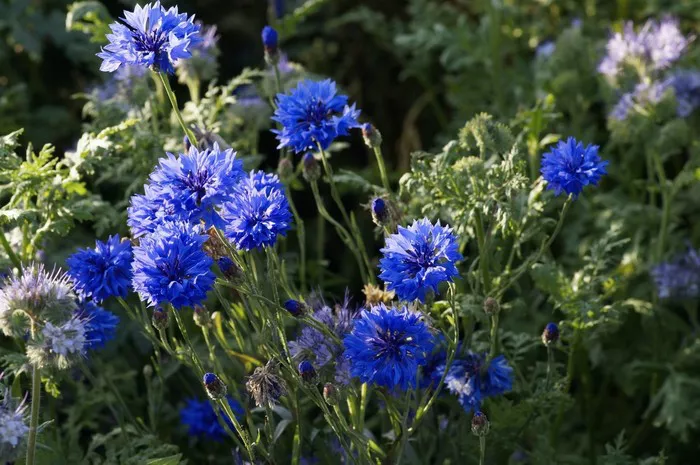In the vast world of flora, certain blooms captivate with their delicate beauty and historical significance. Among these is the cornflower, a charming and resilient wildflower that has adorned landscapes and held cultural importance for centuries.
The Botanical Splendor of Cornflowers
Scientifically known as Centaurea cyanus, the cornflower is a herbaceous annual plant belonging to the Asteraceae family. This dainty wildflower boasts a captivating hue, with its petals displaying a vibrant shade of blue that ranges from pale to intense cobalt. The central disc of the flower is a contrasting dark shade, enhancing its visual appeal. Cornflowers typically bloom in late spring to early summer, carpeting fields and meadows with their delightful blue blossoms.
Cornflower’s Rich History and Cultural Significance
The cornflower’s history is intertwined with diverse cultures and spans centuries. Native to Europe, the cornflower has been a part of the continent’s natural landscape for millennia. It gained cultural significance in the medieval era when it was associated with the Virgin Mary due to its pure blue color, often considered a symbol of heavenly virtues. The cornflower’s presence in fields of grain led to its association with crops, earning it the name “cornflower” — a nod to its companionship with cereal crops like wheat and barley.
Symbolism and Meanings of Cornflowers
Beyond its historical context, the cornflower holds symbolism and meanings that have evolved over time. Traditionally, cornflowers are associated with sentiments of love and fidelity. In the language of flowers, they convey emotions of romance and loyalty, making them a meaningful choice for bouquets and floral arrangements. Additionally, cornflowers have been linked to themes of prosperity and good fortune, reflecting their historical connection with abundant harvests.
Cornflowers in Folklore and Traditions
The rich folklore surrounding cornflowers reflects the deep cultural roots this wildflower has in various traditions. In medieval Europe, it was believed that wearing a cornflower could grant one the ability to see fairies. In German folklore, cornflowers were associated with Freyja, the goddess of love and fertility. Their presence in bridal bouquets was thought to bring blessings to the newlyweds, symbolizing everlasting love and happiness.
Cornflowers in Art and Literature
The cornflower’s allure has not been limited to fields and gardens; it has also found a place in the realms of art and literature. Renowned artists, including Vincent van Gogh, have depicted cornflowers in their paintings, capturing the essence of their vibrant blue petals. In literature, poets and writers have drawn inspiration from the cornflower’s symbolism, weaving its beauty into narratives that explore themes of love, nature, and the human experience.
Cultivation and Growing Cornflowers
Cultivating cornflowers is a rewarding endeavor, whether in a garden or as part of a wildflower meadow. These hardy plants thrive in well-drained soil and prefer full sunlight. Sowing cornflower seeds directly into the soil in early spring or late fall is a common method of propagation. The plants are relatively low-maintenance, requiring moderate watering and minimal fertilization. Their ability to self-seed ensures that they return year after year, gracing the landscape with their vivid blooms.
Cornflowers and Biodiversity
Cornflowers contribute not only to the aesthetic beauty of landscapes but also play a role in supporting biodiversity. As wildflowers, they attract pollinators such as bees and butterflies, promoting ecological balance. The presence of cornflowers in natural habitats provides nectar and pollen resources for these essential pollinators, making them a valuable component of ecosystems.
Varieties of Cornflowers
While the classic blue cornflower is the most well-known, there are several varieties that showcase a range of colors, adding diversity to this charming species. Pink cornflowers, often known as “rose cornflowers,” exhibit soft and romantic hues, while white varieties offer a timeless elegance. These variations allow for creative and colorful landscaping, with different cornflower varieties complementing each other in gardens and floral arrangements.
Cornflowers in Cuisine and Herbalism
Beyond their ornamental appeal, cornflowers have found a place in culinary and herbal traditions. The petals of cornflowers are edible and can be used to enhance both the visual and gustatory aspects of various dishes. Their mild, slightly sweet flavor makes them a popular addition to salads, desserts, and even herbal teas. In herbalism, cornflowers have been historically used for their purported medicinal properties, including anti-inflammatory and soothing effects.
Preserving Cornflowers: Drying and Crafting
Preserving the beauty of cornflowers extends beyond the blooming season. Drying cornflowers allows enthusiasts to enjoy their charm year-round. To dry cornflowers, harvest them when the blooms are fully open and petals are dry. Hang them upside down in a cool, dark place to air-dry. Once dried, cornflowers can be used in various crafts, including potpourri, wreaths, and decorative arrangements. Their delicate and timeless appearance makes them a cherished element in DIY projects.
Cornflowers in Contemporary Gardens and Landscapes
In modern landscaping, cornflowers continue to be a popular choice for those seeking to infuse natural beauty into gardens and open spaces. Their adaptability, coupled with the trend towards wildflower gardening, has led to a resurgence of interest in cornflowers. Gardeners often include them in pollinator-friendly gardens, where their vibrant blooms attract bees and butterflies, contributing to the overall health of the garden ecosystem.
Conclusion
The cornflower’s enduring charm lies not only in its visual appeal but also in the rich tapestry of history, culture, and symbolism it weaves. From ancient folklore to contemporary gardens, cornflowers stand as a testament to the timeless connection between humans and the natural world. As these delicate blue blooms continue to grace fields, gardens, and artistic expressions, they embody a beauty that transcends seasons and speaks to the heart of those who appreciate the allure of wildflowers.


